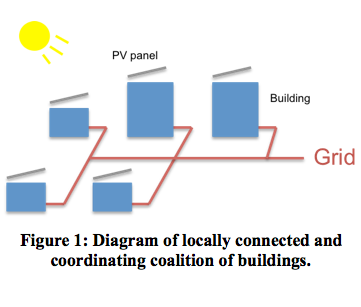|

King Abdulaziz University has signed cooperation contracts with more than 100 distinguished scientists in the framework of the cooperation between our University and other universities and research centers specialized in scientific research, and this is consistent with the policy and principles of the university and its mission, which seeks to provide the best quality education and a high level of its students. It was one of these contracts, a collaboration between the Faculty of Computing and Information Technology and professor Nicholas Jennings at the University of South Hampton in Britain. The contract was signed on the 6th October 2011 for one year.
[+]Coalition Formation for Collaborative Demand Side Management
Effective management of energy generation and distribution is a fundamental problem for human kind. For this reason, this project will explore the use of advance computing (from the areas of AI, multiagent systems and distributed optimization) to develop new algorithms for improving the management of demand-side energy consumption in smart grids. This management improvement stems from forming groups of people and organizations that collectively have a steady level of consumption. We will produce a software simulator to develop and evaluate our novel methods and collaborate with the Royal Commission of Jubail & Yanbu to explore the possibility of transferring these results into practical real world applications, as the industrial city in Yanbu is envisaged to have a well-established infrastructure that can provide us with the relevant contextual (e.g. solar irradiance, wind speed, humidity) and energy data.
[+]The Professional Team Who Work on this Project
- Principal Investigator: Areej Malibari.
|
|
|
|
- Co-Investigator: Yousef AlTurki.
|
|
|
|
- Co-Investigator: Mai Fadel.
|
|
|
|
- Co-Investigator: Daniyal Alghazzawi.
|
|
|
|
- Co-Investigator: Maysoon AboAlkayer.
|
|
|
|
- Highly-cited scholar: Nick R. Jennings.
|
|
|
|
Countries worldwide are facing unprecedented demand for electricity infrastructure expansion as economic development drives lifestyle changes within their populations. For example, electricity consumption in Saudi Arabia is currently growing at 7-8% per annum, and at this rate, peak-time electricity demand is expected to increase by 200% by 2032, largely due to the increased use of commercial and domestic air conditioning. Building additional generation capacity to handle this peak demand and, necessarily, diverting oil production away from export toward domestic generation, are both extremely costly enterprises. Given this, the Saudi Electricity Company is currently planning to spend $80B over the next decade to keep pace with population growth within the Kingdom [1].
The ‘smart grid’ offers an alternative to simply meeting this increase in demand with increased generation capacity. Using two-way information flows between consumers and generators, it seeks to actively manage demand in response to the real-time availability of supply [2]. To date, such demand response has been largely limited to the enforcement of ‘critical pricing periods’, facilitated by ‘smart meters’ that allow time-of-use electricity tariffs, to deter consumers from using electricity intensive appliances (such as air conditioning) at peak times. Such approaches are often unpopular with consumers, and furthermore, both empirical and theoretical studies suggest that they only actually shift the peak in demand to either side of the critical pricing period, rather than eliminating it completely [3,4].
More sophisticated approaches whereby consumers (or more directly, the appliances and buildings that they use) actively negotiate and coordinate their energy use, effectively forming a coalition of consumers, in order to collaboratively reduce their aggregate peak demand for electricity, were first proposed by Schweppe et al. in the 1980s [5,6]. This vision included the ability to incorporate local decentralized energy generation (for Saudi Arabia, this is most likely to be in the form of solar photovoltaic panels), tailoring local consumption to local generation, either to minimize consumption from the grid, or to allow electricity use in the absence of grid electricity. However, it is only recently that the computational infrastructure required to deliver this vision has become a reality. Indeed, the science behind intelligent software agents and multi-agent systems have matured to the extent that these are now seen as essential components to deliver the autonomous intelligent behavior expected of the smart grid [7].
Thus, against this background, there is a clear need to re-visit the vision of collaborative energy consumption, initially described by Schweppe et al., but with the advantage of modern developments in the theory and practice of multi-agent systems and, in particular, computationally efficient algorithms for optimization and coalition formation.

This project will investigate the application of multi-agent systems, and in particular, coalition formation, within a future smart Saudi electricity grid. In particular, it will investigate how groups of consumers (or more directly, the appliances and buildings that they use or the buildings) may form coalitions, under the guidance of intelligent software agents, in order to coordinate their electricity consumption such that they both satisfy their own individual requirements whilst also minimizing their collective demand on the grid. In particular, it will consider coalitions of domestic and commercial buildings, each equipped with solar PV generation and air conditioning units. It will devise optimization algorithms that allow an intelligent agent to manage the energy use of an individual building, exploiting the thermal inertia of the building to maintain comfortable internal temperatures whilst minimizing peak time energy use. Furthermore, it will devise coalition formation algorithms that allow these agents to negotiate and coordinate with other agents, managing the energy use of nearby buildings, to collectively minimize the aggregate demand that they place on the local electricity grid. It will evaluate and demonstrate these algorithms within an integrated software simulation.
To achieve the research objectives outlined above, a work plan is proposed consisting of four interrelated work packages. These work packages focus on (i) modeling the specific setting under consideration, (ii) developing the necessary algorithms to allow individual buildings to optimize their own energy use, (iii) developing algorithms to allow these buildings to coordinate and negotiate with their neighbors to collectively form a coalition with the aim of minimizing aggregate peak demand, and (iv) the integration and demonstration of the resulting system.
In more details:

- WP1: Model Building:
Developing models of: (i) the thermal characteristics of the buildings, (ii) the environment in which they are situated (in terms of daily variation of external air temperature and solar irradiance), and (iii) the local PV generation. These models will subsequently be used both within the demonstrator developed in WP4, and also within the optimization algorithms on the individual buildings developed in WP2. It will build upon existing work within the literature characterizing the thermal behavior of buildings [8], and modeling PV generation [9], and tailor both to the specifics of the setting considered here.
- WP2: Algorithms for Individual Building Optimization:
Developing optimization algorithms to allow an intelligent agent to optimize the energy use of an individual building. This work will be based on existing approaches developed at the University of Southampton that has addressed the optimization of home heating systems. The approach allows the intelligent agent to exploit the thermal inertia of the building to time-shift cooling loads, maintaining comfort levels whilst simultaneously minimizing peak time energy use [10,11].
- WP3: Algorithms for Coalition Formation:
Developing computationally efficient coalition formation algorithms that allow the intelligent agents identified above to negotiate and coordinate with one another to minimize the aggregate demand that they place on the local electricity grid. This work will build upon existing coalition formation algorithms previously developed at the University of Southampton [12,13], adapting and tailoring them to the specific setting considered here.
- WP4: Integration and Demonstration:
Developing an interaction simulator to evaluate and demonstrate the algorithms and mechanisms developed. This simulator will build upon existing components developed within ongoing projects at the University of Southampton (see for example http://www.ideasproject.info/).
The proposed work plan consists of a 9-month research program, with midpoint and endpoint milestones.
| Work Packages |
Month |
| 1 |
2 |
3 |
4 |
5 |
6 |
7 |
8 |
9 |
| Introductory Training Course |
|
|
|
|
|
|
|
|
|
| WP1 Model Building |
|
|
|
|
|
|
|
|
|
| Advanced Training Course |
|
|
|
|
|
|
|
|
|
| WP2 Algorithms for Individual Building Optimization |
|
|
|
|
|
|
|
|
|
| WP3 Algorithms for Coalition Formation |
|
|
|
|
|
|
|
|
|
| WP4 Integration and Demonstration |
|
|
|
|
|
|
|
|
|
| MP1 Interim report and demonstration |
|
|
|
|
|
O |
|
|
|
| MP2 Final report and demonstration |
|
|
|
|
|
|
|
|
O |
This project deals with energy efficiency in two ways; First, optimisation of energy consumptions of current available resources (Oil in Saudi Arabia). Second, incorporating and optimising the use of other sources of energy generators to assist the reduction of energy waste (Solar VP).The results of this project if applied in Saudi Arabia will benefit the country in various ways. It will help reducing the cost of energy consumption for individuals and Coalitions. Moreover minimising the wasted energy will allow current resources to last longer and keep up with the high demand of the expanding cities and the fast growth of population in Saudi Arabia. Most importantly, the outcome of this project, when applied, will reduce the total dependence on fuel and natural gas in generating energy on daily bases. This is a vital matter especially in a country like Saudi Arabia where the economy relies on the amount of Oil consumption.
- The International Resource Journal (2011). The Saudi Electricity Company, http://www.internationalresourcejournal.com/middle_east/saudi_electricity_company_sec.html.
- U. S. Department-Of-Energy (2003). Grid 2030: A national vision for electricity’s second 100 years, Tech. report, Department of Energy.
- Y. Strengers (2010). Air-conditioning Australian households: The impact of dynamic peak pricing, Energy Policy, volume 38, number 11, pages 7312-7322.
- P. Vytelingum, T. Voice, S. Ramchurn, A. Rogers and N. R. Jennings (2011). Theoretical and practical foundations of agent-based micro-storage in the smart grid. Journal of Artificial Intelligence Research, volume 42, pages 765-813.
- F. Schweppe, B. Daryanian, and R. Tabors (1989). Algorithms for a spot price responding residential load controller. IEEE Power Engineering Review, volume 9, number 5, pages 49 – 50.
- R. D. Williams and F. Schweppe (1986). Peak-power-demand limitation through independent consumer coordination. IEEE Transactions on Systems, Man and Cybernetics, volume 16, number 4, pages 560-569.
- S. D. Ramchurn, P. Vytelingum, A. Rogers and N. R. Jennings (2012). Putting the "smarts" into the smart grid: A grand challenge for artificial intelligence. Communications of the ACM. In Press.
- P. Bacher, H. Madsen (2011). Identifying suitable models for the heat dynamics of buildings. Energy and Buildings, volume 43, issue 7, pages 1511-1522.
- D. Dusabe, J. Munda and A. Jimoh (2009). Modelling cloudless solar radiation for PV module performance analysis. Journal of Electricial Engineering, volume 60, number 4, pages 192-197.
- S. D. Ramchurn, K. Vytelingum, A. Rogers and N. R. Jennings, N. (2011). Agent-based control for decentralised demand side management in the smart grid. The Tenth International Conference on Autonomous Agents and Multiagent Systems (AAMAS 2011), Taipei, Taiwan. pages 5-12.
- A. Rogers, S. Maleki, S. Ghosh and N. R. Jennings (2011). Adaptive home heating control through Gaussian process prediction and mathematical programming. Proceedings of the Second International Workshop on Agent Technology for Energy Systems (ATES 2011), Taipei, Taiwan. pages 71-78.
- T. Rahwan, S. D. Ramchurn, A. Giovannucci, and N. R. Jennings (2009). An Anytime Algorithm for Optimal Coalition Structure Generation. Journal of Artificial Intelligence Research, volume 34, pages 521-567.
- T. Rahwan, T. Michalak, M. Wooldridge, and N. R. Jennings (2011). Anytime Coalition Structure Generation in Multi-Agent Systems with Positive or Negative Externalities. Artificial Intelligent Journal. To appear.
|